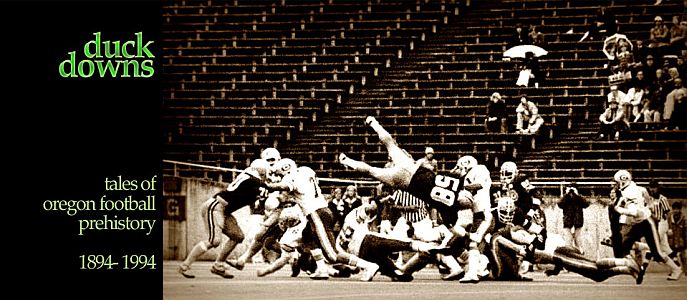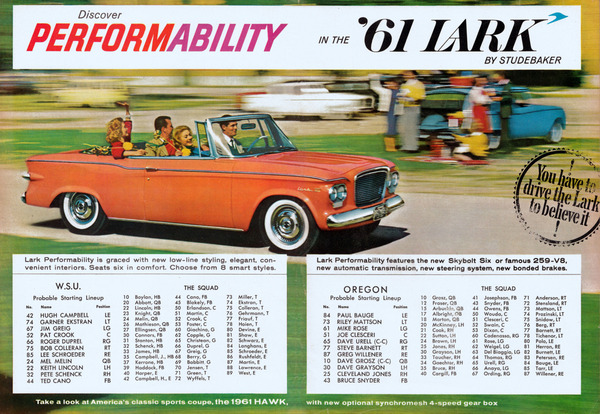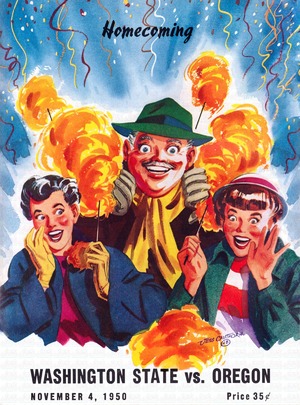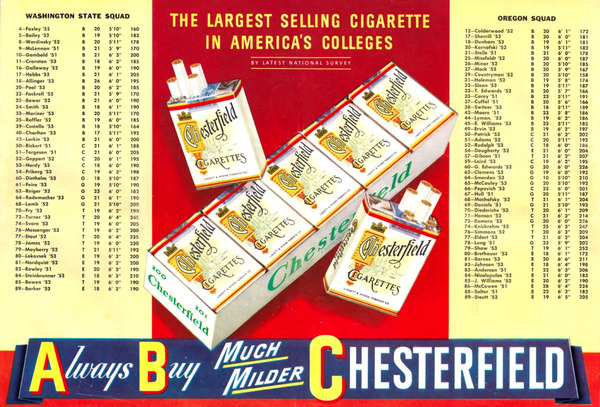October 15, 1960 – Washington State at Oregon (Homecoming)
 September 28, 2011
September 28, 2011  click to embiggenThere was a time when Homecoming was a big deal.
click to embiggenThere was a time when Homecoming was a big deal.
For years the Homecoming game was the excuse for alumni to return to campus, festooned in yellow and green finery. They would stay in spare dorm rooms, in their old frat houses, with friends and family and professors. There would be pep rallies all week, campus tours, a Homecoming Queen would be selected (invariably female), a Friday night bonfire torched off after being guarded all week by frat members against unauthorized ignition by OSC interlopers.
By 1960 there were signs that the Homecoming traditions weren’t exactly being passed on with exuberance to the current student body. The student rallies were casually attended. The traditional variety show didn’t feature the usual slapstick. And the featured musical event, a McArthur Court concert by pianist Roger Williams, seemed to have little to do with either football, homecoming or even the University itself. But it was still Homecoming, one of those things that just “was”.
Eventually it all became a little passé, and – like anything else traditional in the Sixties – perceived as “establishment.” One year the Homecoming festivities were pushed back a week to avoid conflicts with Vietnam war protests. The city of Eugene banned open burning, killing off the bonfire tradition.
And for a few years, roughly from 1975 to 1982, there was no official Homecoming activity of any kind. The Greek system did what it could to keep it going, but the general attitude was of a kind with the way the Seventies had gone in general; the football team wasn’t worth coming home for, and the most famous Homecoming parade associated with the campus in that era featured the Deathmobile and was filmed in Cottage Grove.
Still, back in the day, homecoming meant something. For years at Oregon, when the Civil War was scheduled in Corvallis, it meant a late October game against Washington State, a potentially beatable team to please the old grads back in town for the party. In 1960 Len Casanova’s squad had wins over Idaho, Utah and San Jose State to offset a stinker at Michigan. Because the Ducks were now without conference affiliation, they could be considered for post-season bids, and the schedule was favorable to developing a record impressive enough for the Eastern bowl organizers. Get to seven wins and they’d have a shot at a bowl.
But first they had to eliminate one of those homecoming traditions. The Webfoots hadn’t won a homecoming game since 1955. And the incoming Cougars, after four weeks, were the nation’s #1 passing team, featuring #1 receiver Hugh Campbell. For the first fifty-four, minutes of the game it looked like another loss; QB Dave Grosz had only completed one pass, the Ducks had blown numerous opportunities in WSC territory, and they trailed 12-7. Then, within 42 seconds, everything changed. First Grosz hit end Lew Burnett for a 32 yard touchdown with six minutes left to take the lead 13-12. The PAT was missed, but on the first play after the kickoff, Duck halfback Mike Rose took a 29 yard pick-6 from WSC QB Mel Melin, giving Oregon a 21-12 lead that held to the end of the game.
The 1960 Ducks parlayed later wins at Cal and over Stanford and West Virginia, along with a Civil War tie, into a 7-2-1 record and did get that bowl bid. It wasn’t exactly the dream postseason date, a game in the snow in Philadelphia against Penn State, but it was a bowl, and only the fifth Oregon appearance in postseason play.
Program Notes –
- This issue of Oregon Varsity Review is notably green; not in the current organic sense, but literally printed with green ink, in some kind of a style statement that (fortunately) only lasted one season.
- Curious that the first program advertisement for a color TV is on a monochrome page. The roughly 19” set listed on the inside cover sold for $495 – over $3,600 in current dollars. No remote included.
- There was a time when Advanced Placement was a new concept. That time was around 1960, and a program feature on page 6 touts Oregon’s AP programs. “If a student can complete some of his college work in high school, why ask him to repeat it in college?” (I can think of a few reasons..)
- For once, the center “roster spread” isn’t sponsored by tobacco. Instead it’s the 1961 Studebaker Lark, a sporty convertible, inappropriately festooned in orange, which you apparently had to drive to believe.
- It was the 10th year at Oregon for Cas and assistant coach Jack Roche, and a feature on page 16 wishes the pair a happy anniversary. Oregon AD Leo Harris: “Cas and Jack.. are fine gentlemen who helped us conduct an honorable athletic program through their fine leadership of the young men who have played here. I am sure we all wish them well in the future.”
- The 1960 “Voice of the Ducks,” John Tasnady of KUGN, contributes #9 in the “A Game To Remember” series, the Halloween 1953 victory over USC in Portland. “With the majority of the fourth quarter left to play, the fans watched in wild amazement as the Ducks, with one of the year’s major upsets in reach, fought to maintain their lead…”
- Only one tobacco ad in the 1960 program, on the back cover, but it’s way out, man. Check out those turntables. The guy on the left is obviously squaresville, with his Sibelius and Beethoven and all those other longhairs. No match for the bohemian vixen at right, in the sunny colored booth, with Dave Brubeck, Count Basie, and Ella, showing off the length of her unlit smoke while batting her eyes behind Buddy Holly glasses. Almost makes me want to fire one up. Not really.










